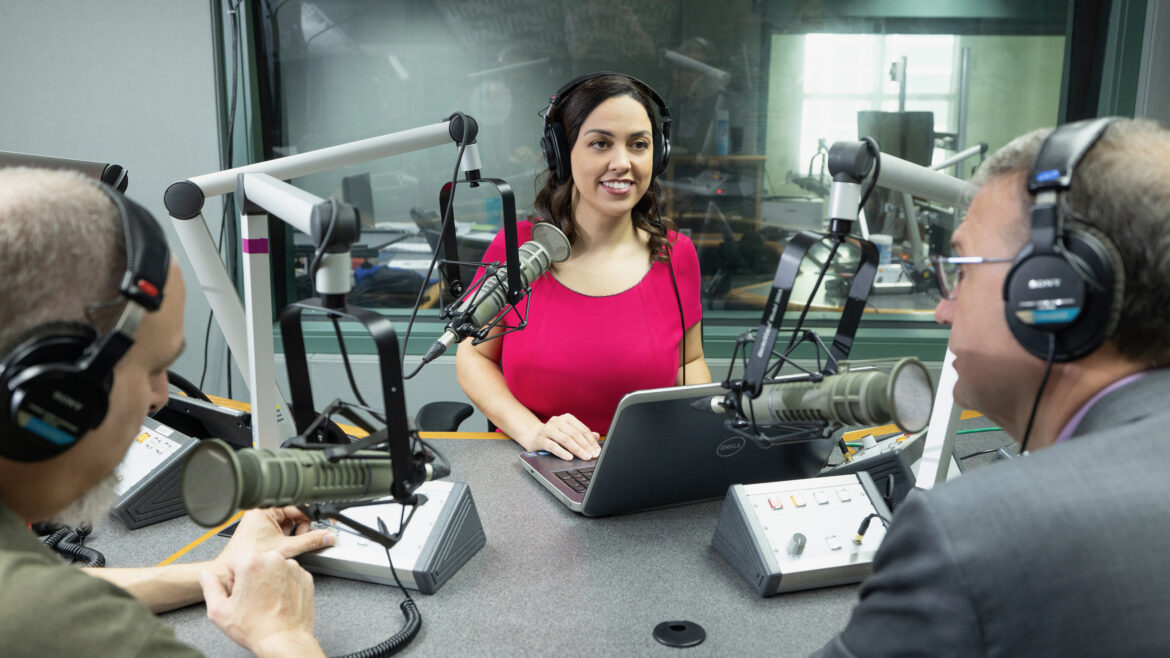WMFE pursues new audiences with weekday show ‘Engage’

WMFE
Cheryn Stone hosts WMFE's new show "Engage."
WMFE in Orlando, Fla., aims to reach younger and more diverse audiences with Engage, a new radio show that launched Feb. 6.
Engage focuses on local issues and allows listeners to interact with the show through email, voicemails and a “Talkback” feature. Through Talkback, listeners can record messages on their phones and send them to Engage using WMFE’s app. Listeners will also be able to have text messages to the show read aloud on air.
These options facilitate connection with diverse audiences, reflecting the changing ways people use technology, said WMFE CEO Judith Smelser.
“We know that the use of smartphones outpaces the use of even a laptop … for younger people, for people of different socioeconomic backgrounds, lower-income people,” Smelser said. “We want to acknowledge that, and we want to make our content and our engagement efforts as accessible to as many different types of people as we possibly can.”
The hourlong show, which airs twice weekly, features in-studio interviews and in-depth stories focused on local issues. Recent topics have included mangrove preservation, anti-LGBTQ+ legislation and the Florida Museum of Black History.
Smelser said Engage has two strategic goals: to increase engagement and trust with existing audiences and underserved communities, and to increase local news and support original content.
“Part of our vision is to lead the community conversation. … I see Engage as the most public, consistent way we’re doing that,” Smelser said. “And by leading the conversation, we don’t mean strong-arm the conversation. We mean shine a spotlight on the things that the community needs to be paying attention to and needs to be talking about and generating that discussion.”

The station hired Engage’s host, Cheryn Stone, in November. Richard E. Copeland joined in January. The show also works with WMFE’s newsroom to feature its reporting.
WMFE is funding Engage out of its core operational budget, which Stone said attracted her to the host position. “Hearing that it was not grant-funded told me that they’re serious about this,” she said. “This isn’t just an idea. This is a commitment to reflecting the community.”
Among the strategies WMFE will use to connect with more diverse audiences are paid advertisements on social media, working with an agency that serves local Black and Caribbean communities, and possibly influencer marketing. WMFE also recently entered into a content-sharing arrangement with The Daytona Times, which serves Black readers.
“You know, this is not rocket science. I know that we’re not the only organization doing this,” Smelser said. “But it’s important to call it out, and it’s important to be intentional about these types of things.”
Engage airs Tuesdays and Thursdays at 3 p.m. WMFE moved Fresh Air to 2 p.m. on those days to make room for Engage.. In addition to Engage, WMFE launched The Wrap, a podcast that provides a weekly roundup of the station’s top stories. The show is targeted toward younger people who typically listen to on-demand audio, Smelser said.
“A lot of people nowadays are not listening linearly,” she said. “They want a one-stop shop for everything that they need to know that they might have missed during the week.”







I hope that the new show does just what the creators intend. It’s also true that appointment radio was never, and is still not “a thing.” Research shows us that format is the best indicator for potential audience. Our stations attract the kind of audience that we program for (and I don’t mean one program). Making this show available online, and on-demand might help, but that negates the immediacy factor for engagement. In the spirit of several articles appearing in Current over the last month or so, I’d respectfully suggest more emphasis on starting additional 24/7 services, that is additional formats, even if (maybe especially if) online only. Block programming has an historic body of research detailing its upsides, and downsides. We need look no further than community radio stations for current examples.